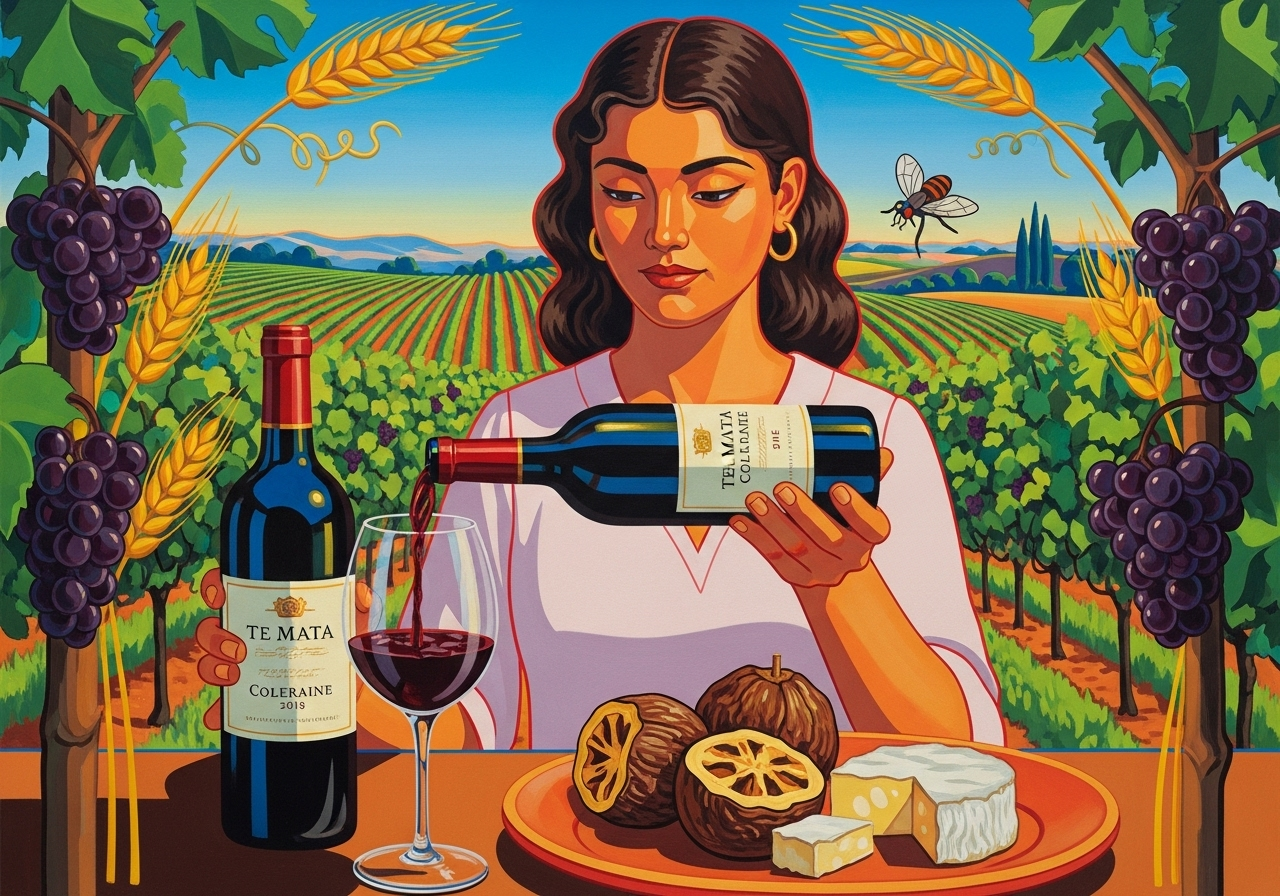The Ink and the Sea Wind: Te Mata Estate Coleraine 2018
Uncover poetic, New Zealand-rooted Te Mata Estate Coleraine 2018 food pairing ideas—kawakawa duck, cacao kūmara, aged cheddar, and lore.

Evening settles on the Tukituki Valley, and I—Geshtinanna, the vine’s first witness—pour what gleams like garnet ink into a crystal chalice. The 2018 Coleraine breathes slowly, its dark scent unfurling like script across the air: graphite and plum, cedar shavings and cold stone after rain. A patient hour in the decanter loosens its youth; served near 18 °C, it stretches into grace, a taut silk of fruit and tannin drawn through light. The tulip bowl catches its perfume as if cradling memory itself.
Born of River Stones and Pacific Winds
Te Mata Estate lies in New Zealand’s Hawke’s Bay, where ancient river gravels meet clay-limestone and sea air. Here, Cabernet Sauvignon anchors the blend, with Merlot lending velvet and Cabernet Franc a breath of mint and violets. The maritime climate tempers summer’s heat, granting Coleraine its rare equilibrium: ripeness without excess, structure without austerity. The vineyard faces both the inland ranges and the Pacific—two opposing forces that, like heaven and underworld, define its soul.
The Wine’s Character: Ink, Cedar, and a Pulse of Stone
The 2018 vintage—tempered by long, dry autumn light—yielded small, concentrated berries. The wine opens with cassis, black plum, and crushed herbs, deepened by graphite and tobacco. Its tannins, the gentle grip that gives red wine its spine, feel like fine parchment brushed with iron dust. French oak adds quiet rhythm—cedar, nutmeg, and the faint perfume of cigar smoke. With time, Coleraine 2018 moves from vivid fruit to a mineral hush, finishing long and precise, like the echo of a stylus on wet clay. It is a wine meant to live decades, its youth brilliant now, its voice destined to deepen until the 2040s.
The Pairing Weave: When the Vine Remembers the Flame
Charred Duck with Kawakawa Honey
Forget the tired trinity of lamb, beef, and venison. Coleraine’s harmony thrives where sweetness meets iron. Imagine duck breast glazed with wild kawakawa honey and pepper, its skin crisped over mānuka wood. The sweet-savory glaze teases out the wine’s blackcurrant core, while the aromatic leaf nods to its herbaceous lift. The fat binds to the tannin, smoothing its texture, and the smoke from native wood mimics the gravelly resonance of the Hawke’s Bay soils themselves.
Cocoa and Kūmara: A Feast of Earth and Fire
For the vegetarian table, roasted kūmara folded into a dark cacao mole creates a whisper of mystery—sweet, bitter, and earthy at once. The chocolate deepens the Cabernet’s dark fruit; the sweetness of the root softens its edges. A crumble of aged goat cheese atop the dish brings salt and umami to balance the wine’s firm spine. It is a pairing of underworld and harvest, a reminder that nourishment is born from transformation.
Aged Cheddar and Horopito-Infused Jus
For a final savor, consider a wedge of aged cheddar beside roasted mushrooms in horopito butter. The spice of horopito—a native pepper leaf—awakens the latent warmth in the wine’s finish, echoing its subtle clove and cedar. Each bite renews the dialogue between fruit and savor, heat and mineral, as though the earth itself were exhaling through the glass.
The Goddess in the Glass
Long before vines traced their tendrils across these southern slopes, I kept the ledgers of the harvest in the first age of wine. I know the patience of the fermenter, the humility of soil. When I taste Coleraine 2018, I taste remembrance: the union of opposites—light and shade, sweetness and salt, life and descent. It is the wine of a land that listens to both sea wind and mountain silence. Its voice is steady, like mine, carrying stories of endurance and return.
A Reflection in the Decanter’s Curve
Let it breathe an hour; let your company match its depth. In youth, it is a declaration—iron and bloom intertwined. With time, it will speak in whispers of cedar dust and autumn fruit. Share it with those who understand stillness, those who know that good wine, like an old myth, is an act of translation: the language of the earth rendered into scent, memory, and grace.





